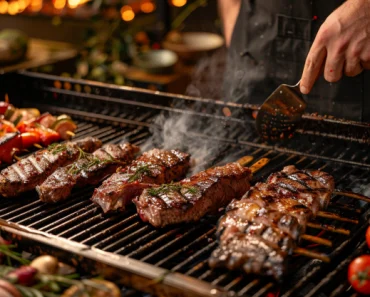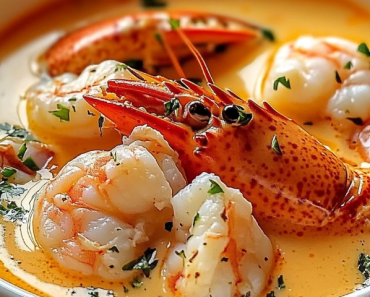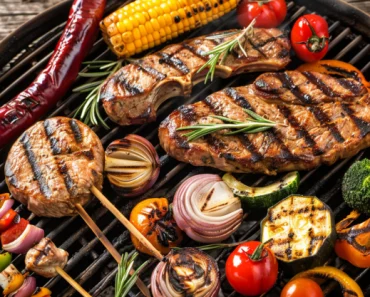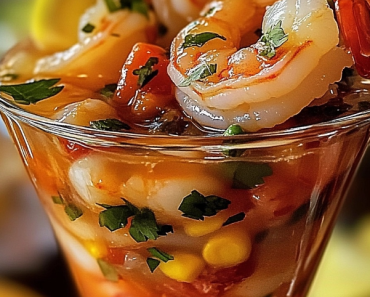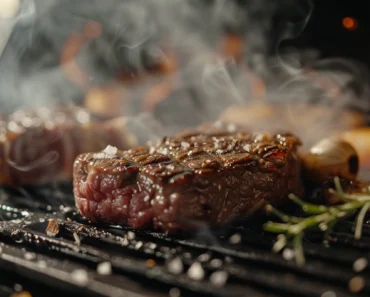ADVERTISEMENT
Introduction
Grilling is a popular cooking method that not only enhances the flavor of food but also provides a fun and engaging way to cook. From summer barbecues to weekend gatherings, grilling brings people together. This article explores five foods that can be grilled, offering tips and recipes to elevate your grilling game. By understanding the variety of foods that can be grilled, you can expand your culinary repertoire and enjoy delicious, smoky flavors all year round. Whether you’re a novice or an experienced griller, discovering new foods that can be grilled will make your outdoor cooking sessions more exciting and flavorful.
1. Steaks
Grilling steaks is a classic and beloved method for preparing this popular meat, celebrated for its ability to enhance flavor and texture. Here’s a guide to grilling steaks:
Types of Steaks for Grilling
- Ribeye: Known for its rich, beefy flavor due to its marbling.
- Sirloin: Offers a good balance of flavor and tenderness without too much fat.
- T-bone: Features both a strip of sirloin and a tender filet mignon, offering a dual experience.
- Filet Mignon: The most tender cut, but less fatty, so it’s often wrapped in bacon or served with sauces.
Preparation Tips
- Seasoning: Simple salt and pepper can suffice, but you can also marinate or use steak rubs to enhance the flavor. Always season generously.
- Temperature: Remove steaks from the refrigerator about 30 to 40 minutes before grilling to let them come to room temperature. This helps in cooking the steak evenly.
Grilling Tips
- Preheat the Grill: Ensure your grill is hot before placing the steaks on it, which helps create a nice sear that locks in juices.
- High Heat: Start with high heat to sear the steak and get those attractive grill marks, then lower the heat to your desired doneness.
- Cooking Time: Cooking times vary based on thickness and desired doneness. Typically, a 1-inch thick steak will take about 4-5 minutes per side for medium-rare.
- Turning the Steak: Turn the steak only once during grilling. Use tongs to flip the steak, as forks can puncture the meat and release valuable juices.
- Checking Doneness: Use a meat thermometer to ensure perfect doneness. For medium-rare, aim for an internal temperature of 130-135°F (54-57°C), medium 140-145°F (60-63°C), and well-done 160°F (71°C) and above.
- Resting: Let the steak rest for about 5 to 10 minutes after grilling under a foil tent. This allows the juices to redistribute throughout the meat, making it juicier and more flavorful.
Serving Suggestions
- Accompaniments: Serve steaks with sides like grilled vegetables, mashed potatoes, or a fresh salad.
- Sauces: Enhance steaks with classic sauces such as béarnaise, peppercorn, or a simple compound butter.
Grilling steaks is as much an art as it is a science, combining technique with personal preference to achieve the perfect result. Whether for a special occasion or a casual dinner, a well-grilled steak can be a satisfying and delicious centerpiece.
2. Vegetables
Grilling vegetables is a wonderful way to enhance their natural flavors, adding a delightful char and smokiness that can elevate any meal. Here’s how to master the art of grilling vegetables:
Types of Vegetables for Grilling
- Bell Peppers: Their sweet, robust flavor intensifies with grilling.
- Zucchini and Summer Squash: These vegetables get tender and flavorful on the grill.
- Asparagus: Grilling brings out a nutty flavor in asparagus.
- Corn on the Cob: Grilling corn enhances its natural sweetness.
- Mushrooms: Portobello mushrooms are particularly good for grilling, developing a meaty texture.
- Onions: Sliced thick, onions caramelize beautifully with direct heat.
Preparation Tips
- Cleaning and Cutting: Wash vegetables thoroughly. Cut them into sizes that will cook evenly and won’t fall through the grill grates.
- Marinating: While not always necessary, marinating can add extra flavor to vegetables, especially zucchini, bell peppers, and mushrooms. Use ingredients like olive oil, balsamic vinegar, garlic, herbs, and spices.
Grilling Tips
- Oil the Vegetables: Lightly brush the vegetables with oil to prevent sticking and to add flavor. You can also use a grill basket for smaller veggies.
- High Heat: Preheat the grill to a medium-high heat. High heat helps to sear the vegetables and seal in flavors.
- Turn Regularly: Use tongs or a spatula to turn the vegetables regularly for even cooking and to achieve those beautiful grill marks.
- Cooking Times: Cooking times vary depending on the vegetable. Dense vegetables like potatoes will take longer, typically 20-30 minutes, whereas softer vegetables like asparagus may take only 4-6 minutes.
Flavor Enhancements
- Seasonings: Salt and pepper are essential, but you can also experiment with other seasonings such as chili flakes, smoked paprika, or curry powder for a unique twist.
- Herbs: Fresh herbs like rosemary, thyme, or basil can be sprinkled over the vegetables either before or after grilling for added flavor.
- Sauces and Dressings: After grilling, drizzle vegetables with a vinaigrette or a squeeze of fresh lemon juice to enhance their natural flavors.
Serving Suggestions
- Salads: Combine grilled vegetables with fresh greens, nuts, and a robust cheese like feta or goat cheese for a hearty salad.
- Side Dishes: Serve alongside grilled meats or as part of a vegetarian platter.
- Sandwiches and Wraps: Add grilled vegetables to sandwiches and wraps for extra flavor and nutrition.
Grilled vegetables are not only delicious but also a healthy addition to any meal, offering a fantastic way to enjoy the bounty of the garden. They’re versatile enough to be included in nearly any meal, enhancing the dish with their smoky, caramelized flavors.
3. Seafood
Grilling seafood is a delightful way to bring out its natural flavors while adding a smoky essence that enhances the overall taste. Here’s how to successfully grill various types of seafood:
Types of Seafood for Grilling
- Fish: Sturdy fish like salmon, tuna, and swordfish are ideal for grilling because they hold up well to the heat. Delicate fish such as flounder or sole can also be grilled but are best done in a grilling basket to prevent falling apart.
- Shrimp: Large shrimp are perfect for grilling, either skewered or in a grill basket.
- Scallops: Large, plump scallops are fantastic when grilled, developing a nice crust on the outside while remaining tender inside.
- Lobsters and Crabs: Grilling lobsters and crabs infuse them with a smoky flavor that is simply irresistible.
- Shellfish: Mussels, clams, and oysters can be grilled until they just open, making them a simple and elegant dish.
Preparation Tips
- Preparation: Ensure that all seafood is clean and prepared properly. For fish, scales should be removed, and the fish should be patted dry.
- Marination: Mild marinades can enhance seafood without overpowering its delicate flavors. Use ingredients like olive oil, lemon juice, herbs, and spices.
Grilling Tips
- High Heat: Preheat your grill to a high temperature. This helps to sear the seafood, sealing in the juices.
- Non-Stick Surface: Oil the grill grates well to prevent sticking, or use a grilling mat or basket for smaller pieces of seafood.
- Skin-on: When grilling fish with the skin on, start skin-side down to get a crispy skin. The skin also helps keep the fish together.
- Quick Cooking: Seafood generally cooks quickly, often in just a few minutes per side. Watch it closely to avoid overcooking, which can make it dry and tough.
Flavor Enhancements
- Herbs and Spices: Season seafood with fresh herbs like dill, parsley, or cilantro and spices such as paprika or garlic powder.
- Butter and Sauces: A dab of butter or a light sauce can be applied towards the end of grilling to add richness and flavor.
- Lemon and Lime: A squeeze of lemon or lime just before serving brings out the seafood’s flavors and adds a fresh zest.
Serving Suggestions
- Accompaniments: Serve grilled seafood with fresh salads, grilled vegetables, or over a bed of pasta or rice.
- Sauces: Accompany with sauces like tartar, remoulade, or a simple vinaigrette.
- Platters: Create a mixed seafood platter with a variety of grilled seafood items for a delightful presentation.
Grilling seafood can turn a simple meal into a memorable feast. It’s a quick, healthy, and flavorful way to enjoy the fresh tastes of the sea, perfect for casual dinners or elegant gatherings.
4. Chicken
Grilling chicken is a versatile and popular way to cook this lean meat, imparting rich flavors and attractive grill marks that enhance its appeal. Here’s a comprehensive guide to successfully grilling chicken:
Types of Chicken for Grilling
- Boneless, Skinless Breasts: Quick and easy to cook, ideal for health-conscious meals.
- Thighs and Drumsticks: Higher fat content makes these cuts more flavorful and moist when grilled.
- Wings: Perfect for appetizers or snacks, they become wonderfully crispy on the grill.
- Whole Chicken: Can be grilled using a rotisserie attachment or by butterflying (spatchcocking) to lay flat on the grill for even cooking.
Preparation Tips
- Brining or Marinating: Soaking chicken in a brine or marinade before grilling can enhance flavor and moisture, especially for breast meat.
- Seasoning: Apply a dry rub or simply season with salt, pepper, and your favorite herbs and spices. For an extra flavor boost, under-skin seasoning on whole chickens distributes flavors directly onto the meat.
- Room Temperature: Let the chicken sit out for 30 minutes before grilling to ensure more even cooking.
Grilling Tips
- Preheat the Grill: Heat your grill to medium-high heat for breasts and wings, and medium for thighs, drumsticks, and whole chickens.
- Oil the Grill: Prevent sticking by brushing the grill grates with oil before placing the chicken on them.
- Direct vs. Indirect Heat: Start chicken pieces over direct heat to sear the surface and then move to indirect heat to finish cooking without burning. Whole chickens benefit from indirect heating throughout to ensure they cook through without charring.
- Use a Meat Thermometer: Ensure chicken is cooked to a safe internal temperature of 165°F (74°C). Insert the thermometer into the thickest part of the meat without touching the bone.
Flavor Enhancements
- Basting: Baste the chicken with a sauce or marinade during the last few minutes of grilling to add a layer of flavor. Be cautious with sugar-based sauces, as they can burn easily.
- Smoking: Add wood chips to your grill to impart a subtle smoky flavor to the chicken.
- Lemon and Garlic: These classic flavors pair wonderfully with grilled chicken, offering a fresh and aromatic profile.
Serving Suggestions
- Sides: Serve grilled chicken with sides such as grilled vegetables, salads, or a refreshing coleslaw.
- Sauces: Offer sauces like BBQ, honey mustard, or a homemade salsa to complement the grilled flavors.
- Sandwiches and Salads: Use grilled chicken in sandwiches, wraps, or atop fresh green salads for a satisfying meal.
Grilled chicken is not only delicious but also adaptable to a variety of cuisines and dietary preferences, making it a staple for family dinners and social gatherings alike. With the right preparation and grilling techniques, you can achieve perfectly grilled chicken that is juicy, flavorful, and enjoyed by all.
5. Fruits
Grilling fruits is an excellent way to enhance their natural sweetness and add a delightful charred flavor, making them a perfect complement to savory dishes or a standalone treat. Here’s how to successfully grill various types of fruits:
Types of Fruits for Grilling
- Pineapple: Thick slices or rings of pineapple become caramelized and even sweeter on the grill.
- Peaches and Nectarines: Halved and pitted, these stone fruits develop a delicious, warm juiciness when grilled.
- Bananas: Grilled in their skins, bananas transform into a soft, gooey dessert.
- Apples: Sliced thickly, apples can be grilled to enhance their tartness and sweetness.
- Watermelon: Grilled watermelon steaks offer a unique twist, with a slightly smoky flavor and firmer texture.
Preparation Tips
- Slicing: Cut fruits into large slices or chunks to ensure they don’t fall through the grill grates and to allow for easier turning.
- Pitting: Remove pits from stone fruits like peaches, plums, and cherries to prevent charring and make grilling more manageable.
- Pre-cooking: Firmer fruits like apples or pears can be pre-cooked slightly to shorten grilling time and ensure they’re tender.
Grilling Tips
- Medium Heat: Grill fruits over medium heat to avoid burning the natural sugars too quickly.
- Oil Lightly: Lightly brush the fruit with oil to prevent sticking. Coconut oil adds a nice flavor and is perfect for high-heat cooking.
- Direct Heat: Use direct heat for quick grilling and to achieve those attractive grill marks.
- Short Cooking Time: Most fruits cook quickly, often in just a few minutes per side. Watch closely to avoid overcooking, which can lead to mushiness.
Flavor Enhancements
- Marinades: Briefly marinate fruits in a mixture of honey, cinnamon, or vanilla to enhance their flavor before grilling.
- Seasonings: A sprinkle of salt can heighten the sweetness of grilled fruits. For a spicy kick, a pinch of chili powder works well, especially on mango or pineapple.
- Herbs: Fresh herbs like mint, basil, or thyme can be sprinkled on grilled fruits for added freshness and complexity.
Serving Suggestions
- Desserts: Serve grilled fruits with a scoop of ice cream, drizzle with honey, or sprinkle with toasted nuts for a decadent dessert.
- Salads: Add grilled fruit to salads for a sweet and savory flavor combination.
- Sauces and Salsas: Puree grilled fruits to make sauces for meats or chunky salsas for chips and tacos.
- Cocktails: Use grilled fruits to infuse or garnish cocktails, adding a smoky sweetness to your drinks.
Grilled fruits offer a unique and delicious way to enjoy the natural flavors of summer and beyond. They provide a versatile option for enhancing both sweet and savory dishes, bringing a creative twist to traditional grilling sessions. Among the many foods that can be grilled, fruits stand out for their ability to caramelize and develop rich, complex flavors. Incorporating grilled fruits into your meals showcases the diverse range of foods that can be grilled, adding variety and excitement to your outdoor cooking. By exploring different foods that can be grilled, you can elevate your culinary skills and delight your taste buds with innovative and flavorful dishes.
Conclusion
In conclusion, grilling offers a diverse and delightful way to prepare a variety of foods that can be grilled, from classic meats like steaks and chicken to more unexpected choices like fruits and vegetables. Each type of food benefits uniquely from the high heat and smoky flavors of the grill, enhancing both taste and texture. Steaks gain a charred exterior and juicy interior, vegetables develop a sweet, smoky depth, and fruits caramelize their natural sugars for a warm, rich flavor.
Furthermore, the act of grilling itself provides not only delicious results but also an enjoyable cooking experience that can be both social and interactive. Whether you’re cooking for a casual family dinner or a larger gathering, the variety of foods that can be grilled makes grilling versatile enough to accommodate a wide range of dietary preferences and culinary styles.
By mastering the techniques and tips for grilling different types of foods that can be grilled, you can transform simple ingredients into gourmet dishes that impress and satisfy. Remember to prioritize safety and proper preparation to ensure the best outcomes. With a little practice and creativity, grilling can elevate your cooking and provide delightful meals that highlight the best flavors of each season, showcasing the endless possibilities of foods that can be grilled.
ADVERTISEMENT

